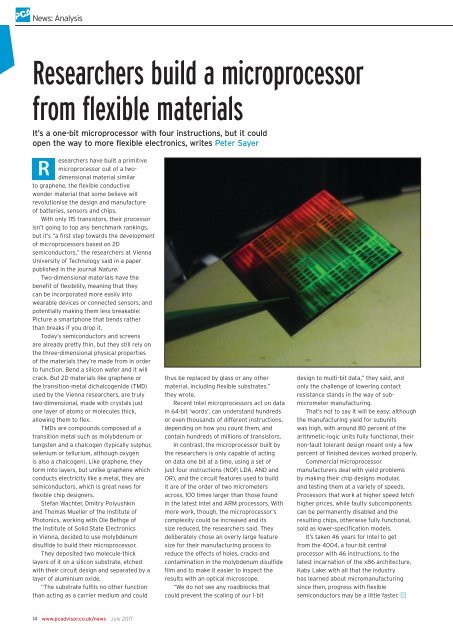Create successful ePaper yourself
Turn your PDF publications into a flip-book with our unique Google optimized e-Paper software.
News: Analysis<br />
Researchers build a microprocessor<br />
from flexible materials<br />
It’s a one-bit microprocessor with four instructions, but it could<br />
open the way to more flexible electronics, writes Peter Sayer<br />
R<br />
esearchers have built a primitive<br />
microprocessor out of a twodimensional<br />
material similar<br />
to graphene, the flexible conductive<br />
wonder material that some believe will<br />
revolutionise the design and manufacture<br />
of batteries, sensors and chips.<br />
With only 115 transistors, their processor<br />
isn’t going to top any benchmark rankings,<br />
but it’s “a first step towards the development<br />
of microprocessors based on 2D<br />
semiconductors,” the researchers at Vienna<br />
University of Technology said in a paper<br />
published in the journal Nature.<br />
Two-dimensional materials have the<br />
benefit of flexibility, meaning that they<br />
can be incorporated more easily into<br />
wearable devices or connected sensors, and<br />
potentially making them less breakable:<br />
Picture a smartphone that bends rather<br />
than breaks if you drop it.<br />
Today’s semiconductors and screens<br />
are already pretty thin, but they still rely on<br />
the three-dimensional physical properties<br />
of the materials they’re made from in order<br />
to function. Bend a silicon wafer and it will<br />
crack. But 2D materials like graphene or<br />
the transition-metal dichalcogenide (TMD)<br />
used by the Vienna researchers, are truly<br />
two-dimensional, made with crystals just<br />
one layer of atoms or molecules thick,<br />
allowing them to flex.<br />
TMDs are compounds composed of a<br />
transition metal such as molybdenum or<br />
tungsten and a chalcogen (typically sulphur,<br />
selenium or tellurium, although oxygen<br />
is also a chalcogen). Like graphene, they<br />
form into layers, but unlike graphene which<br />
conducts electricity like a metal, they are<br />
semiconductors, which is great news for<br />
flexible chip designers.<br />
Stefan Wachter, Dmitry Polyushkin<br />
and Thomas Mueller of the Institute of<br />
Photonics, working with Ole Bethge of<br />
the Institute of Solid State Electronics<br />
in Vienna, decided to use molybdenum<br />
disulfide to build their microprocessor.<br />
They deposited two molecule-thick<br />
layers of it on a silicon substrate, etched<br />
with their circuit design and separated by a<br />
layer of aluminium oxide.<br />
“The substrate fulfils no other function<br />
than acting as a carrier medium and could<br />
thus be replaced by glass or any other<br />
material, including flexible substrates,”<br />
they wrote.<br />
Recent Intel microprocessors act on data<br />
in 64-bit ‘words’, can understand hundreds<br />
or even thousands of different instructions,<br />
depending on how you count them, and<br />
contain hundreds of millions of transistors.<br />
In contrast, the microprocessor built by<br />
the researchers is only capable of acting<br />
on data one bit at a time, using a set of<br />
just four instructions (NOP, LDA, AND and<br />
OR), and the circuit features used to build<br />
it are of the order of two micrometers<br />
across, 100 times larger than those found<br />
in the latest Intel and ARM processors. With<br />
more work, though, the microprocessor’s<br />
complexity could be increased and its<br />
size reduced, the researchers said. They<br />
deliberately chose an overly large feature<br />
size for their manufacturing process to<br />
reduce the effects of holes, cracks and<br />
contamination in the molybdenum disulfide<br />
film and to make it easier to inspect the<br />
results with an optical microscope.<br />
“We do not see any roadblocks that<br />
could prevent the scaling of our 1-bit<br />
design to multi-bit data,” they said, and<br />
only the challenge of lowering contact<br />
resistance stands in the way of submicrometer<br />
manufacturing.<br />
That’s not to say it will be easy: although<br />
the manufacturing yield for subunits<br />
was high, with around 80 percent of the<br />
arithmetic-logic units fully functional, their<br />
non-fault tolerant design meant only a few<br />
percent of finished devices worked properly.<br />
Commercial microprocessor<br />
manufacturers deal with yield problems<br />
by making their chip designs modular,<br />
and testing them at a variety of speeds.<br />
Processors that work at higher speed fetch<br />
higher prices, while faulty subcomponents<br />
can be permanently disabled and the<br />
resulting chips, otherwise fully functional,<br />
sold as lower-specification models.<br />
It’s taken 46 years for Intel to get<br />
from the 4004, a four-bit central<br />
processor with 46 instructions, to the<br />
latest incarnation of the x86 architecture,<br />
Kaby Lake: with all that the industry<br />
has learned about micromanufacturing<br />
since then, progress with flexible<br />
semiconductors may be a little faster. J<br />
14 www.pcadvisor.co.uk/news <strong>July</strong> <strong>2017</strong>


















